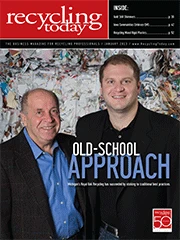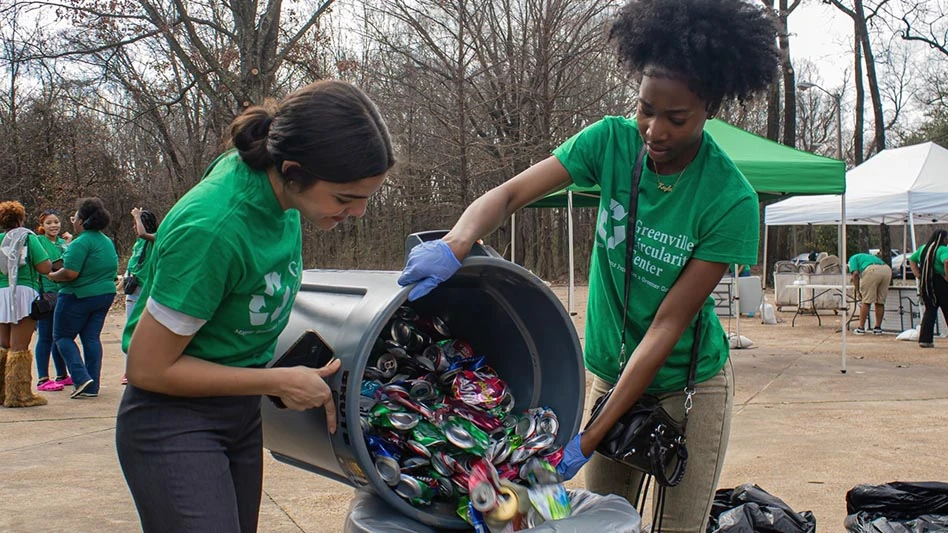 The use of plastic packaging is popular with many industries, including produce, dairy, pet care and fast food, making it prevalent in the waste stream. However, up until recently, only the low-hanging fruit, such as PET (polyethylene terephthalate) beverage containers, HDPE (high-density polyethylene) natural milk jugs and colored detergent and shampoo bottles, has been collected for processing.
The use of plastic packaging is popular with many industries, including produce, dairy, pet care and fast food, making it prevalent in the waste stream. However, up until recently, only the low-hanging fruit, such as PET (polyethylene terephthalate) beverage containers, HDPE (high-density polyethylene) natural milk jugs and colored detergent and shampoo bottles, has been collected for processing.
Having ignored all other plastics for so long, recycling programs and residents are struggling to find ways to divert “other” plastics from landfills. While significant progress has made, much remains to be done, most importantly establishing an industry-accepted set of specifications.
Looking back on the last decade, we can see the evolution of the waste handling infrastructure in the United States. Maximizing diversion rates for recyclables from the postconsumer waste stream has yielded attractive dividends to companies that own or operate material recovery facilities (MRFs). The introduction of single-stream recycling has helped to increase participation among consumers.
Residents have become more interested in recycling nonbottle plastics, and these containers are showing up at MRFs and drop-off locations around the country. It is a logical progression, and these items are sometimes included in curbside programs, but there has yet to be an industry-wide change. While many MRFs can remove nonbottle plastics from PET and HDPE bottles, which have clearly defined industry accepted specifications, many MRFs vary widely in how they deal with “other” plastics.
The trend in handling these other plastics, commonly referred to as “bulky rigids” and “3 through 7,” has been to commingle them, selling the mixed plastic bale to the highest bidder. This resulted in bales that lacked consistency from one MRF to another, leading to confusion among buyers and processors. Most MRF operators have learned through trial and error to determine the mixture that yields the best return and keeps buyers interested in their baled mixed plastics every month.
Brokers often serve as the conduit between processor and producer, sharing information they obtain from consuming mills about what they consider valuable and what is undesirable. Companies like Universal Commodity Services Inc. (UCS) of Brooklyn, N.Y., are doing just that. With two specification sheets published online at www.ucsincny.com/ucs/specification-sheets, UCS has successfully set up pilot programs and guided MRFs on ways to improve their quality, facilitating year-round movement of these mixed plastics bales.
Many communities have MRFs equipped to process nonbottle plastics. However, without a standardized specification, communities are hesitant to encourage residents to recycle bulky rigids.
Grade Standardization
Efforts are finally converging between industry leaders and trade associations to channel resources toward defining a set of industry-accepted specifications for nonbottle mixed plastics. The Institute of Scrap Recycling Industries Inc.’s (ISRI’s) Plastic Council has teamed up with the Association of Postconsumer Plastic Recyclers (APR) to study bale composition in an effort to standardize the grade and publish it in ISRI’s “Scrap Specifications Circular.” This can only occur after an in-depth analysis, debate and ISRI board approval. By having industry veterans such as ReCommunity, a MRF operator, and buyers of mixed plastics, such as UCS, provide input on the specs, real industry knowledge and experience is sure to be incorporated.
|
MRP – Mixed Rigid Plastics According to Universal Commodity Services’ spec sheet, acceptable bulky plastic components of mixed rigid plastics bales include:
More information is available at www.ucsincny.com/ucs/specification-sheets. |
Varying equipment configurations at MRFs and the many different plastic items being recycled at the curb can make specifications for mixed plastics confusing. To simplify grading, many veteran operators in the industry have successfully adopted the following approach. First, they draw a distinction between flexible packaging, such as grocery film, and rigid packaging containers. Once a system for removing film is in place, the MRF distinguishes between bulky rigid plastics (like toys, buckets, totes, crates, lawn furniture) and small plastic containers (such as tubs, lids and clam shells). The former, MRP (mixed rigid plastics), are commonly removed during the presort process. The latter, SPC (small plastic containers), travel along the conveyor system and down the sort line at the MRF.
A, B and C grades distinguish bale quality and value of MRP and SPC. Bales with glass have no value in light of their low yield and lack of demand. MRP and SPC with excessive levels (10 to 15 percent) of flexible packaging (grocery bags) and fiber are considered Grade C. Grade C has limited demand, and anyone producing MRP/SPC is encouraged to strive to produce better quality.
Grade B contains no fiber and 5 to 10 percent undesirable components, which include film and some low-value plastic components (VHS tapes, audio cassettes, PVC (polyvinyl chloride, PET thin trays, PET microwave trays, agricultural pots/trays). This grade has moderate demand, though prices are more sensitive to market conditions.
MRP and SPC Grade A contain no noticeable glass/metal/fiber contamination and less than 5 percent undesirable plastic components. The only way to produce A quality material is through a positive sort. It’s composed of predominantly HDPE and PP (polypropylene) with some PS (polystyrene) and PET. White HDPE containers with heat shrunk film sleeves are a common item that adds value to SPC. Optical sorting machines are unable to sort these sleeved HDPE bottles as HDPE mixed color, and the material ends up in the MRF’s residual stream or in SPC.
Determining Value
Value is based on yield and labor. A bale with bigger pieces, less residue and no noticeable contaminants always will command a higher price, as a processor can produce a higher yield and use less labor. Processors compete more aggressively on clean MRP because it is less of a quality risk. As well, clean MRP can be converted more quickly, resulting in quicker cash turnover than lower grades.
|
SPC – Small Plastic Containers According to Universal Commodity Services’ spec sheet, acceptable components of small plastic container bales include:
Call to confirm if other plastic containers are acceptable. More information is available at www.ucsincny.com/ucs/specification-sheets. |
Color also plays a role. Bales with more black are considered lower value, even if they’re clean and uniform. The regrind they yield is of lower value to end users in light of the limited applications for black plastics.
Facilities capable of producing separate MRP and SPC grades typically benefit in the form of higher prices and steady movement, regardless of the market.
Plants that commingle their MRP and SPC into a single bale are limited to an MRP-B grade price. Prices are at least 2 cents to 4 cents per pound higher for Grade A than Grade B and are less affected by the market, which can be described as seasonal. Historically, as the winter approaches, demand declines and supply stays constant, leading to a softening of prices between November and March.
MRP and SPC contain plastics well suited for consumption by domestic and foreign mills. These factories demand a feedstock of consistent quality to facilitate smooth operation. Plants that sort, wash and grind mixed plastics value consistency as it enables them to maintain high throughput to efficiently produce high-quality, clean regrind. Compounders demand clean, uniform regrind to make high-quality reprocessed pellets. End users such as injection molders must have good repro pellets to blend with virgin to produce an end product that meets their high-quality standards. All parties in the supply chain benefit from a uniform feedstock (MRP/SPC), enabling production of a sustainable, high-quality end product from postconsumer resin.
The concept of recycling has existed as long as waste itself, going back to ancient times. While we have come a long way over the years, too many components of our waste stream still are bound for the landfill. Despite our progress, we still have a long way to go before claiming to have maximized diversion. It takes the ingenuity and commitment of industry, commerce and the general public to achieve a sustainable existence. The efforts of many in the recycling industry to keep rigid plastics and small plastic containers out of landfills is the only way zero-waste can one day become reality.
The author is president of Universal Commodity Services Inc., with locations in Charlotte, N.C., and Brooklyn, N.Y. He can be reached at ibeylin@ucsincny.com.
Igor Beylin of Universal Commodity Services discusses sorting 3 through 7 plastics and small plastic containers (SPC) in an interview with Recycling Today’s Kristin Smith at www.RecyclingToday.com/paper-recycling-conference-interview-igor-beylin.aspx.

Explore the January 2013 Issue
Check out more from this issue and find your next story to read.
Latest from Recycling Today
- OnePlanet Solar Recycling closes $7M seed financing round
- AMCS launches AMCS Platform Spring 2025 update
- Cyclic Materials to build rare earth recycling facility in Mesa, Arizona
- Ecobat’s Seculene product earns recognition for flame-retardant properties
- IWS’ newest MRF is part of its broader strategy to modernize waste management infrastructure
- PCA reports profitable Q1
- British Steel mill subject of UK government intervention
- NRC seeks speakers for October event





